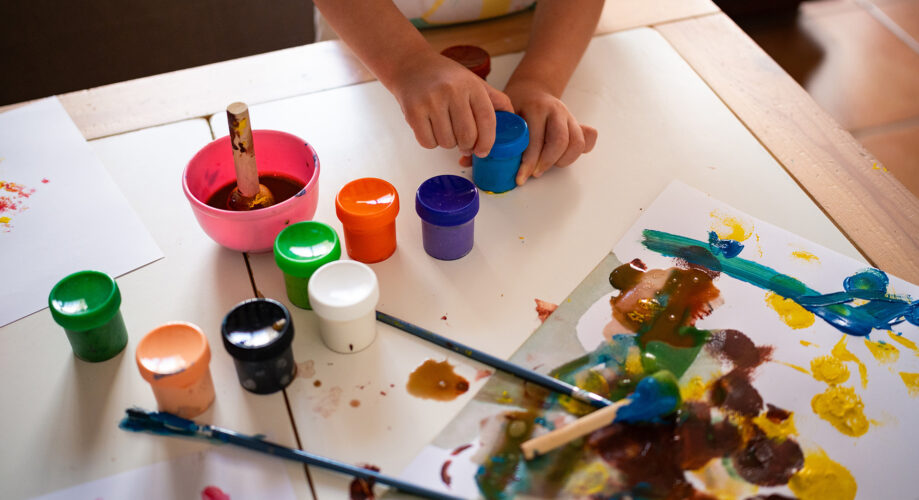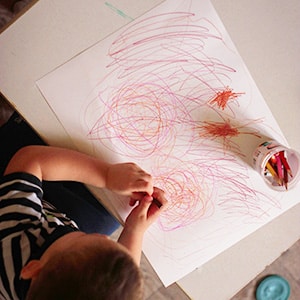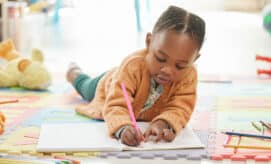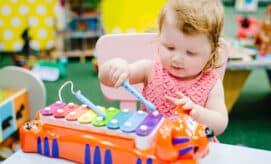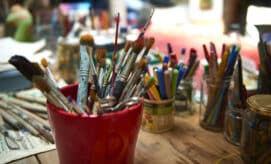To set up this activity, offer children paper and a variety of writing utensils, such as colored pencils, crayons, and markers. Encourage the children to explore by alternating colors and observing the way the colors interact with each other on the paper. You might talk with little ones about the way they can fill their paper by drawing large, flowing lines, or by using small, tight scribbles. For a great stress-reliever, invite the children to compare light versus heavy pressure by alternating between scribbling while holding the writing utensil lightly on the paper’s surface and using their muscles to press hard as they scribble.
This activity helps children relieve stress and frustration, build sensory awareness, and develop fine motor skills in their hands and fingers!
2. Puff Paint Art
Using paint that involves squishing and squeezing the containers to get the paint colors onto paper is especially good for wiggly, fidgety early learners! A great example is puff paint, which is fun to use and creates a dimensional, puffy effect when applied to paper. Puff Paint is available at craft supply stores and at stores like Walmart and Target. It’s also possible to make your own puff paint with just a few ingredients.
To set up a puff paint activity, offer children a selection of paints in different colors, along with recycled pieces of cardboard, cardstock paper, unused paper plates, or any other items you have available that might make a good canvas. Squeezing the paint from its bottle is fun for kids…and it helps them release any tension or stress being held in the body.
As children squeeze out the paint, you might invite them to notice how that feels in their body– what does it feel like in their hands and fingers, and what muscles are they using? You can also engage them in the activity by sharing your enthusiasm, perhaps saying something like, “We can squeeze out all of our frustration and angry feelings as we squish these bottles! Grrrrr! Let’s try it together!” Or, as the children are finishing up their project, you might give a big sigh and say, “My body feels so much more relaxed now!” This helps little ones start to understand that some activities can also be a tool for relieving feelings of stress or anger.
3. Colors of my Feelings
This simple activity uses color to help children connect to and describe their feelings. Start by asking little ones about the kinds of feelings they are experiencing that day, and invite them to think about the color that best expresses the way they feel.
Then, offer the children a variety of art supplies, such as crayons, paints, markers, and maybe even stickers, stamps, or pom-poms in the colors that each child has selected. Encourage them to create artwork that uses the colors that represent their feelings. Older children might enjoy using the colors to draw pictures that illustrate their feelings, such as a happy sun or an angry bear.
This art activity is a fun and engaging way for little ones to practice exploring emotions and strengthening emotional skills. Color offers a way for children to envision feelings, and art activities can become a tool for expressing feelings and emotions.
4. Do-a-Dot Bottles
Stamping color onto a piece of paper is another great way to release tension while making art! To get started, offer children a variety of do-a-dot paints in different colors along with construction paper. (If you do not already have do-a-dots in your classroom, they can be found at stores such as Target, Walmart, and craft stores.) Encourage children to create colorful designs by stamping or pounding the dot paints on paper to create colorful designs.
As children stamp on the paper, talk with them about how it feels to press firmly onto the paper to make patterns and designs. Ask them about the various colors they’re using, and what types of feelings those colors might represent.
Art & Emotions: Tips for Educators
- Create a calming art environment. The way that art activities are introduced and the setting in which they take place can have a significant impact on the way children experience the activity. Try to create a calm environment by dimming the lights in your classroom or by playing peaceful background music. Try to avoid clutter by reducing the number of art supplies that are out at one time. These steps will help children become calm and ready to engage in a creative activity.
- Let children lead the way. If we want children to express themselves through their art, we have to allow them to take the lead on their own projects. Educators can encourage children to choose colors and materials that they are interested in so that they are using items that resonate with their feelings at that moment.
- Focus on the process. These kinds of projects are all about creativity, exploration, and self-expression during the creative process. This means focusing on the process of making art, rather than on the final product. Engage children in conversation about what they are feeling, why they selected different materials, and the process of making their artwork.
You might also be interested in these articles from G2K, with examples of active art activities that support motor skill development, and collaborative art projects that promote community building!

